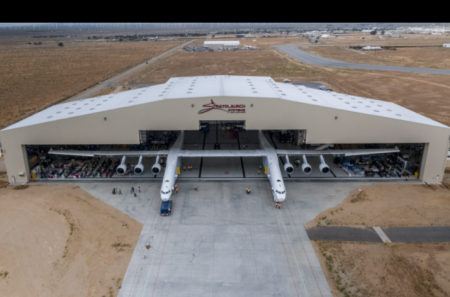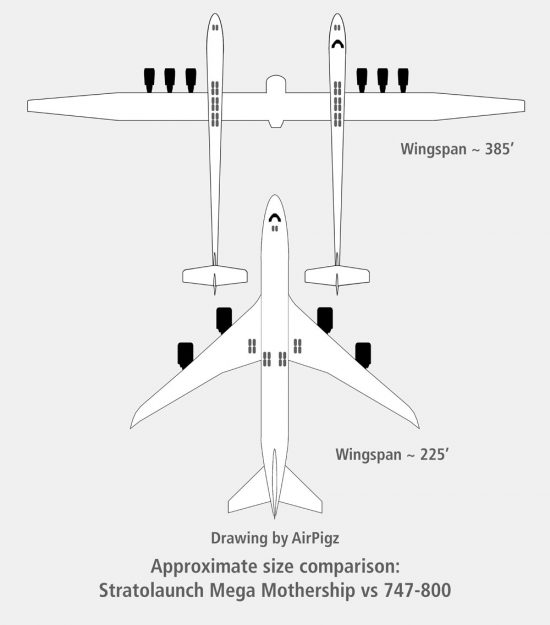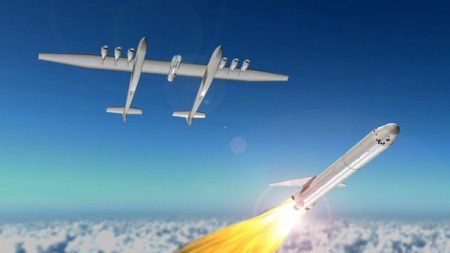June 2, 2017 – A twin-fuselage six-jet-engine monster aircraft with an 118 meter (385 foot) wingspan made its debut this week. You can see it below emerging from its hangar.

The aircraft measures 72.5 meters (238 feet) in length and 15.2 meters (50 feet) in height. It is the world’s largest aircraft. A comparison illustration seen below positions it next to a Boeing 747-800, the second largest commercial passenger jet in use today.

Paul Allen, who along with Bill Gates, founded Microsoft, has spent a portion of his personal fortune chasing a childhood dream to be a part of the space programme. He has written, “After Apollo, NASA shifted to unmanned probes. Space lost its cachet, but it never lost my interest.” Now he intends to be part of the space race, and he has done this over the last four years, deconstructing two Boeing 747-400 aircraft and adapting six of their Pratt-Whitney jet engines to a new composite twin-fuselage combination wing and spar system.
Allen calls his creation, Stratolaunch, a reusable aircraft designed to put satellites into low-Earth orbit. The dual fuselages are made of composite materials. the right fuselage houses the flight crew. The left contains the flight data systems. The center wing and spar provide flight stability and the attachment point for one or more launch vehicles with payloads. Maximum launch capacity is 250,000 kilograms (500,000 pounds). Maximum weight for Stratolaunch at take-off is 590,000 kilograms (1.3 million pounds).
The aircraft can fly from standard jet-length runways. If it can handle a Boeing 747 it can handle Stratolaunch. Cruising altitude and launch point is approximately 9,000 meters (30,000 feet). At that height, much of the thick lower atmosphere lies below making launching and getting to orbit much easier.
Stratolaunch can be positioned anywhere a commercial jetway exists. Its flying radius, is 1,850 kilometers (1,150 miles), making it possible to move away from inclement weather to ensure safer launches.
With the rollout this week expect extensive ground tests before the first maiden flight. The first demonstration launch is scheduled for early in 2019. The launch will carry less than maximum payload, probably one or more Orbital ATK Pegasus XLs, a proven air-launch rocket that has previously put multiple Cyclone Global Navigation Satellite Systems into orbit.
Allen has a history of building spaceplanes. He teamed up with Burt Rutan at Scaled Composites to build SpaceShipOne which helped the two of them win the Ansari XPrize. SpaceShipOne was a smaller prototype for what is today’s Stratolaunch.
SpaceShipTwo, the successor to Allen’s first project, is now owned by Richard Branson. Branson hopes to launch an edge-of-space tourism business with it. And Branson also plans to put air launched satellites into low-Earth orbit in competition with Allen. Not to be outdone, DARPA has contracted Boeing and Aerojet Rocketdyne to build a multi-use spaceplane able to deploy payloads of 1,360 kilograms (3,000 pounds) to low-Earth orbit. These three should be in business before the end of the decade, dramatically driving down the cost to get to space.









